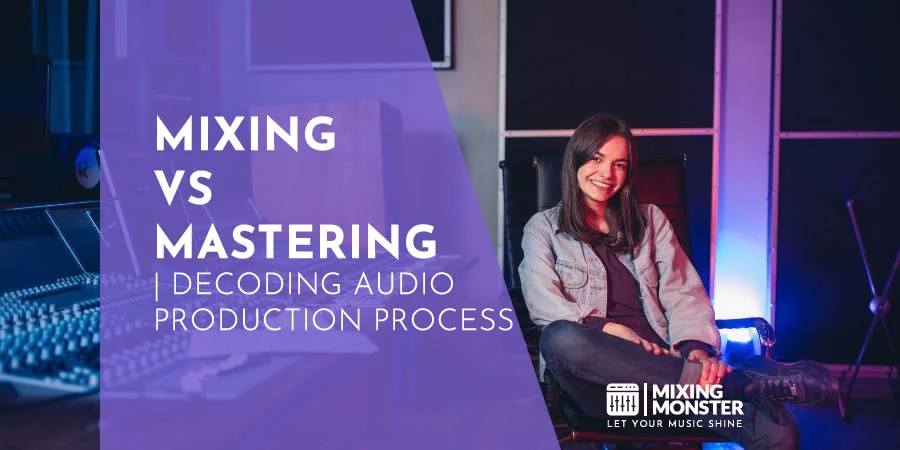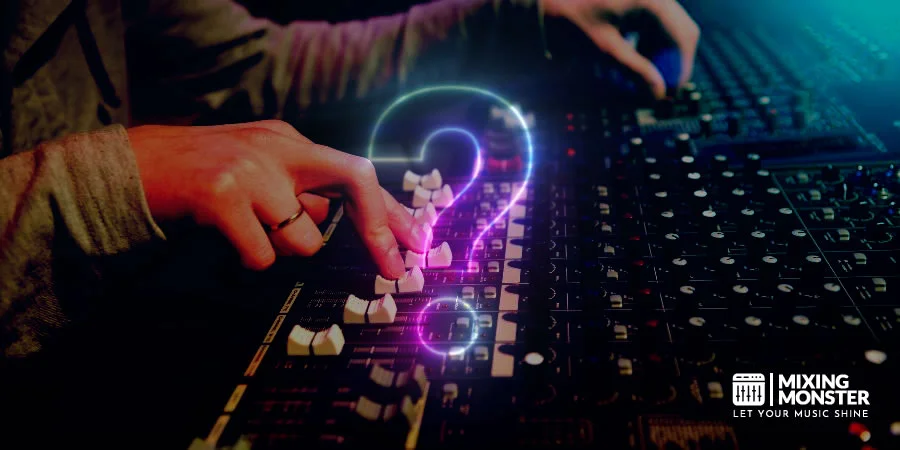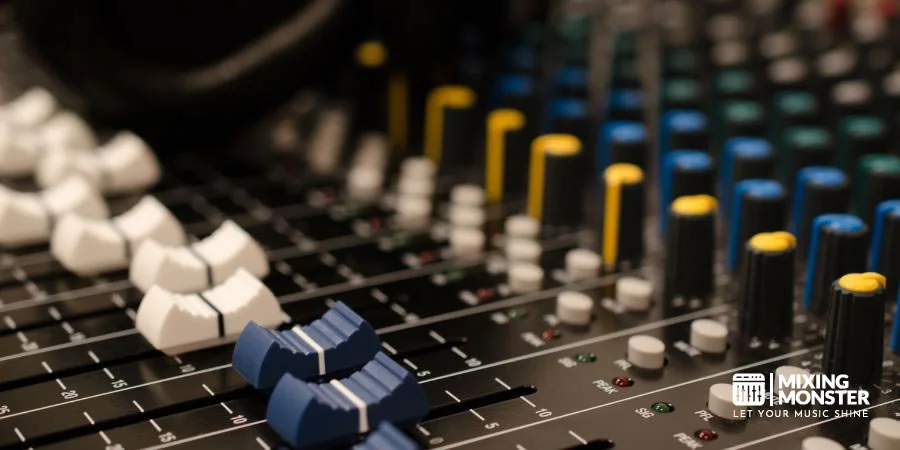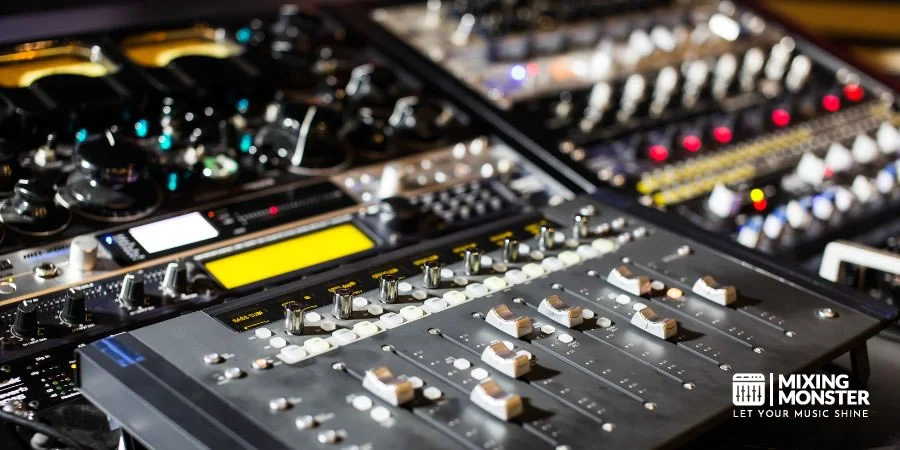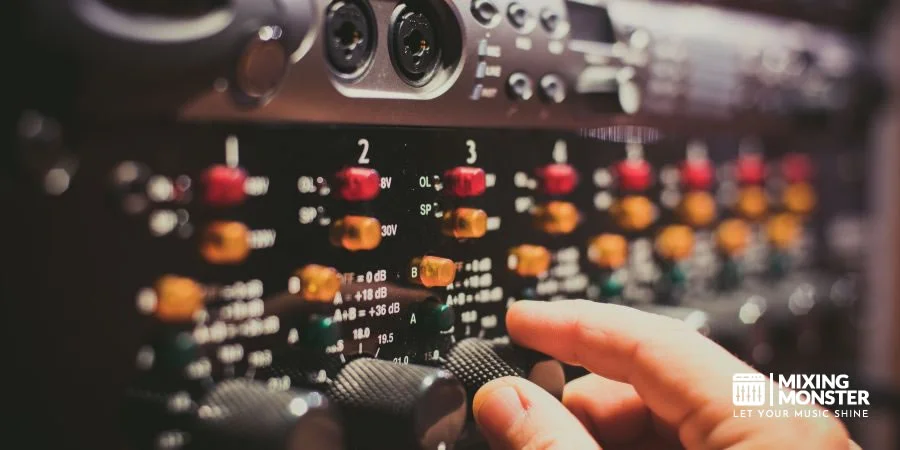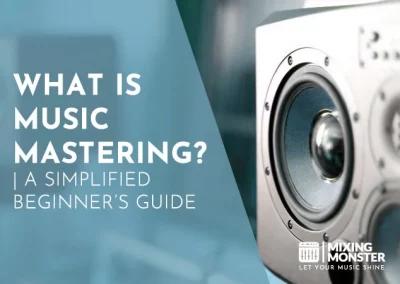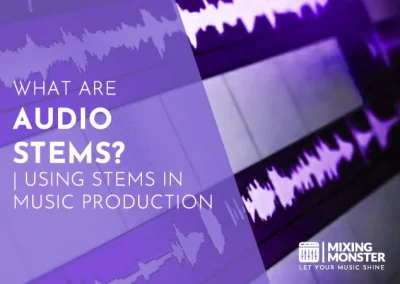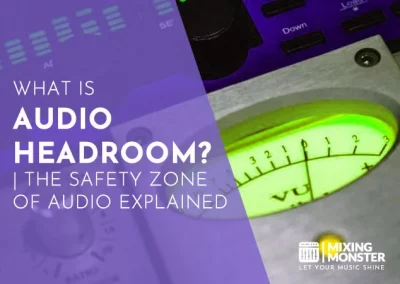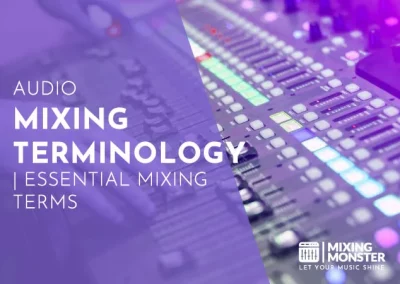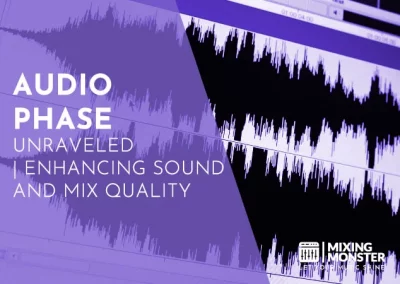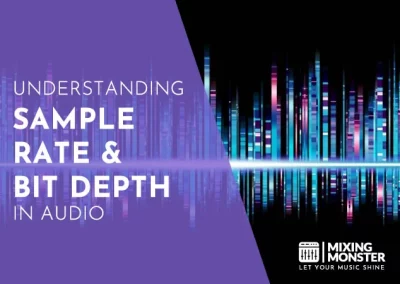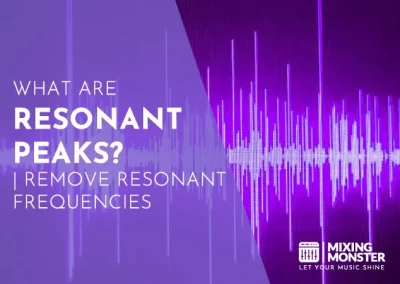Home > Blog > Mixing > Mixing Insights
In the realm of audio production, mixing and mastering are two critical processes that shape the final sound of a project. This article will explore the distinct roles of mixing vs mastering, delving into their unique techniques and objectives, to provide a clear understanding of their differences and importance in the music production landscape.
Audio mixing involves balancing and enhancing individual tracks by adjusting volume, equalization, panning, and adding effects. Mastering, however, is the final stage in music production, ensuring a cohesive sound across the album and optimizing the mix for various playback systems and formats.
Mixing and mastering are the secret ingredients that transform raw recordings into polished, professional tracks. Discover how these two distinct yet essential processes work together to create the magic that captivates listeners and elevates your music to new heights.
Table Of Contents
1. The Role Of Audio Mixing And Mastering In Music Production
2. The Audio Mixing Process
3. The Audio Mastering Process
4. The Difference Between Mixing And Mastering
5. The Different Processing In Mixing Vs Mastering
6. Mixing And Mastering Your Own Music Vs. Hiring A Professional
7. Audio Mixing Vs Mastering – Two Separate Processes

1. The Role Of Audio Mixing And Mastering In Music Production
Audio mixing and mastering are distinct yet essential stages in the music production process, and understanding their differences is crucial to achieving a polished, professional sound.
Audio mixing focuses on balancing and enhancing individual tracks within a song. This process involves adjusting volume levels, applying equalization for tonal balance, setting panning for spatial placement, and adding effects such as compression and reverb. Mixing ensures that all elements blend harmoniously, resulting in a cohesive and polished mix.
On the other hand, audio mastering is the final stage in music production, aiming to optimize the mix for various playback systems and formats. Mastering involves fine-tuning the overall sound, applying techniques like final equalization, stereo width enhancement, compression, limiting, and sequencing. This process ensures consistency, appropriate loudness, and clarity across all tracks on an album.
Distinguishing between mixing and mastering is essential because each process serves a unique purpose and requires specific skills and tools.
Mixing deals with individual song elements, while mastering focuses on the final product’s cohesiveness and translation across listening environments.
Recognizing these differences helps artists and producers allocate appropriate resources and time to each stage, ultimately achieving a high-quality, professional sound.
2. The Audio Mixing Process
The audio mixing process is a crucial stage in music production, aimed at enhancing and balancing individual tracks to create a harmonious and polished mix.
The primary goal of audio mixing is to ensure that all elements within a song work well together, resulting in a balanced and sonically pleasing listening experience.
This involves refining each track’s sound, maintaining a proper balance between them, and emphasizing or de-emphasizing specific elements as needed. Several techniques are employed during the mixing process:
Overview Of Audio Mixing Techniques:
- Volume Levels:
Adjusting the relative loudness of each track to achieve a balanced mix. - Panning:
Positioning tracks within the stereo field to create a sense of space and depth. - Equalization (EQ):
Modifying the frequency response of individual tracks to create tonal balance and eliminate frequency clashes. - Compression:
Controlling the dynamic range of tracks by reducing the difference between the loudest and softest parts, resulting in a more consistent sound. - Reverb:
Adding ambience and depth to tracks by simulating the natural reflections of sound in various environments.
Mixing engineers use a variety of tools to achieve the desired sound:
Overview Of Audio Mixing Tools:
- Mixing Consoles:
Analog or digital boards with channels, faders, and knobs for adjusting levels, EQ, and other parameters. - Digital Audio Workstations (DAWs):
Software applications that allow for the recording, editing, and mixing of audio tracks. Examples include Pro Tools, Logic Pro, Ableton Live, and FL Studio. - Plugins:
Software-based processors that provide additional effects, dynamics control, and EQ options. These plugins can be used within a DAW to further shape and enhance the sound.
In case you want to learn more about the audio mixing process, here are some articles to get you started:
3. The Audio Mastering Process
The audio mastering process is the final stage in music production, focusing on refining the overall sound and ensuring that the mix translates well across different listening systems and platforms.
The distinct goal of audio mastering is to optimize the final mix for consistency, clarity, and appropriate loudness, allowing the music to sound its best on various playback devices, such as headphones, speakers, and streaming platforms. Techniques employed during the mastering process are different compared to the mixing process:
Overview Of Audio Mastering Techniques:
- Final Equalization:
Applying subtle EQ adjustments to address any remaining tonal imbalances and enhance the mix’s overall tonality. - Compression:
Applying gentle compression to glue the mix together and ensure a consistent dynamic range. - Stereo Width Enhancement:
Adjusting the stereo field’s width to create an immersive listening experience without compromising mono compatibility. - Limiting:
Using a limiter to control peak levels and increase the overall perceived loudness without introducing distortion. - Sequencing:
Arranging the tracks in the desired order, setting appropriate spacing between them, and creating smooth transitions for a cohesive listening experience.
Like mixing engineers, mastering engineers use different tools during the mastering process:
Overview Of Audio Mastering Tools:
- Mastering Software:
Specialized applications designed for the mastering process, such as iZotope Ozone, WaveLab, and Steinberg’s Mastering Edition. - Hardware Processors:
Outboard gear, including equalizers, compressors, and limiters, that provide analog warmth and color to the sound. - Audio Analyzers:
Tools that offer visual feedback on various aspects of the audio, such as frequency response, stereo width, and dynamic range, enabling the engineer to make informed decisions during the mastering process.
In case you want to learn more about the audio mastering process, here are some articles to get you started:
4. The Difference Between Mixing And Mastering
Audio mixing and mastering are two separate stages in the music production process, each serving a distinct purpose and employing specific techniques and tools.
Mixing Vs. Mastering Goals:
-
- Mixing focuses on balancing and enhancing individual tracks within a song, ensuring that all elements blend harmoniously and create a polished mix.
- Mastering optimizes the final mix for consistency, clarity, and appropriate loudness, enabling the music to sound its best on various playback devices and platforms.
Mixing Vs. Mastering Techniques:
-
- Mixing involves adjusting volume levels, applying equalization for tonal balance, setting panning for spatial placement, and adding effects such as compression and reverb.
- Mastering employs techniques like final equalization, stereo width enhancement, compression, limiting, and sequencing to refine the overall sound and create a cohesive listening experience.
Mixing Vs. Mastering Tools:
-
- Mixing tools include mixing consoles, digital audio workstations (DAWs), and plugins that provide effects, dynamics control, and EQ options.
- Mastering tools encompass specialized mastering software, hardware processors for analog warmth and color, and audio analyzers for visual feedback on various aspects of the audio.
Sequence In The Music Production Process:
-
- Mixing comes first in the production process, after the recording stage.
- Mastering follows mixing as the final stage in music production.
Understanding these key distinctions between mixing and mastering is essential for effectively allocating resources and time to each stage and ultimately achieving a high-quality, professional sound.
Mixing Vs. Mastering:
| Aspect | Audio Mixing | Audio Mastering |
| Purpose | Balance and enhance individual tracks | Optimize final mix for various playback systems and formats |
| Focus | Individual elements within a song | Overall sound and cohesion across an album |
| Techniques | Volume levels, equalization, panning, compression, reverb | Final equalization, stereo width enhancement, compression, limiting, sequencing |
| Tools | Mixing consoles, DAWs, plugins | Mastering software, hardware processors, audio analyzers |
| Engineer’s Role | Blending and polishing individual tracks | Ensuring consistency, loudness, and clarity across tracks |
| Stage in Process | Middle of the production process | Final stage in the music production process |
| Outcome | A balanced, polished mix | A cohesive, consistent, and professionally finished product, meeting audio standards |

5. The Different Processing In Mixing Vs Mastering
The difference between audio mixing and audio mastering processing lies in their respective goals, techniques, and the subtlety of the processing applied.
Again, mixing focuses on balancing and enhancing individual tracks within a song, while mastering optimizes the final mix for consistency, clarity, and appropriate loudness across various playback devices and platforms.
Let’s focus on the most important processing techniques in audio mixing and mastering. When it comes to equalizers, compressors, and limiters, their usage differs significantly between mixing and mastering:
Equalizers:
-
- Mixing: During mixing, EQ adjustments are more flexible and can be more aggressive, aiming to shape the tone and create space for each track within the mix. For instance, removing low-end rumble from non-essential elements or boosting specific frequencies to help a vocal or instrument stand out.
- Mastering: EQ adjustments in mastering are more subtle and surgical, focusing on correcting minor tonal imbalances and enhancing the overall mix’s tonality. Mastering engineers might apply gentle shelving filters or use narrow notches to address specific frequency issues.
Compressors:
-
- Mixing: Compression in mixing serves to control the dynamic range of individual tracks, making them more consistent and helping them sit better within the mix. Mixing engineers may use higher compression ratios and faster attack/release settings on specific tracks to achieve the desired sound.
- Mastering: Compression in mastering is more gentle and transparent, intended to glue the mix together and ensure a consistent dynamic range across the entire track. Lower compression ratios and slower attack/release settings are typically used to maintain the mix’s natural dynamics while adding cohesion.
Limiters:
-
- Mixing: Limiters are occasionally used during mixing to control peak levels on individual tracks or groups, preventing digital clipping. Mixing engineers may apply limiters with conservative settings, focusing on taming occasional peaks rather than significantly increasing loudness.
- Mastering: Limiters play a crucial role in mastering, ensuring that the overall perceived loudness is competitive without introducing distortion. Mastering engineers use limiters with more precise settings, aiming to control peak levels while retaining the mix’s dynamic integrity.
On average, mastering processing is generally more subtle and surgical than mixing, as it deals with refining the overall sound rather than individual elements.
Both mixing and mastering are crucial stages in music production, and understanding their differences is essential for achieving a polished, professional result.
6. Mixing And Mastering Your Own Music Vs. Hiring A Professional
Attempting to mix and master your own music versus hiring a professional comes with its own set of pros and cons. Here’s an exploration of the factors to consider when making this decision:
DIY Mixing & Mastering:
Pros:
- Cost-Effective:
Saves money, as you won’t need to pay professional rates. - Skill Development:
Provides an opportunity to learn valuable techniques and develop a deeper understanding of the music production process. - Creative Control:
Allows you to maintain full control over the creative direction and final sound.
Cons:
- Limited Experience:
Steeper learning curve and potentially limited expertise compared to professionals. - Time-Consuming:
Requires a significant time investment to learn and implement techniques. - Less Objectivity:
It may be difficult to maintain objectivity and make unbiased decisions when working on your own music. - Limited Access To Equipment:
You may have restricted access to high-quality gear, software, and plugins compared to a professional studio. - Acoustic Environment:
Home studios may lack proper room acoustics and monitoring setups necessary for accurate mixing and mastering.
Hiring A Professional:
Pros:
- Skill & Experience:
Access to skilled, experienced engineers who can deliver high-quality results. - Objectivity:
Engineers provide a fresh, unbiased perspective, which is essential for achieving a polished sound. - Time-Saving:
A dedicated engineer can deliver results faster than DIY, allowing you to focus on other aspects of your music career. - Equipment & Tools:
Professionals have access to high-quality, industry-standard gear, software, and plugins. - Acoustic Environment:
Professional studios offer optimized listening spaces, ensuring more accurate mixing and mastering decisions. - Networking & Collaboration:
Working with professionals can help build relationships within the industry and open opportunities for collaboration.
Cons:
- Cost:
Hiring a professional can be expensive, depending on the engineer’s rates and the project’s scope. - Less Hands-On Involvement:
You may have less direct involvement in the technical process, which can be a downside if you want to learn and develop your own skills.
DIY Mixing And Mastering Vs. Hiring A Professional:
| Factor | DIY Mixing & Mastering | Hiring a Professional |
| Cost | Pros: Saves money | Cons: Can be expensive, depending on the engineer’s rates |
| Skill & Experience | Cons: Steeper learning curve, limited expertise | Pros: Access to experienced, skilled engineers |
| Objectivity | Cons: Difficult to maintain objectivity on your own work | Pros: Engineers provide fresh, unbiased perspective |
| Time | Cons: Can be time-consuming to learn and implement techniques | Pros: Faster turnaround time with a dedicated engineer |
| Equipment & Tools | Cons: Limited access to high-quality gear, software, and plugins | Pros: Engineers have access to professional-grade tools |
| Acoustic Environment | Cons: Inadequate room acoustics, lack of proper monitoring setup | Pros: Professional studios offer optimized listening spaces |
| Networking & Collaboration | Cons: Missed opportunities for networking and collaboration | Pros: Build relationships with industry professionals |
| Quality & Consistency | Cons: Potential for lower-quality results, less consistency | Pros: Higher-quality, more polished, and consistent sound |
| Learning Opportunity | Pros: Develop valuable skills, gain a deeper understanding of music | Cons: Less hands-on involvement in the technical process |
Weighing the pros and cons of DIY mixing and mastering versus hiring a professional depends on factors such as budget, skill level, time, and desired quality. It’s essential to consider these aspects when deciding which approach best suits your needs and goals as a musician.
7. Audio Mixing Vs Mastering – Two Separate Processes
In conclusion, understanding the difference between audio mixing and mastering is crucial for producing high-quality music.
While mixing focuses on balancing and enhancing individual tracks to create a cohesive and polished mix, mastering optimizes the final mix for consistency, clarity, and appropriate loudness across various playback devices and platforms.
Each stage requires unique techniques, tools, and expertise to achieve the desired results. Musicians must carefully consider whether to take on these tasks themselves or hire professionals, weighing factors such as budget, skill level, and desired quality.
Ultimately, a well-executed mixing and mastering process is vital to achieving a professional, polished sound that stands out in today’s competitive music landscape.
Are you interested in getting your song mixed and mastered by Mixing Monster?

